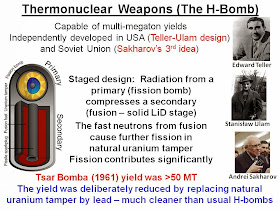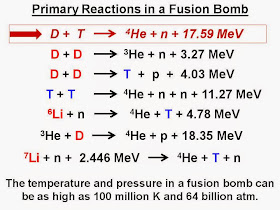Development and Testing of the Hydrogen Bomb
Uranium and plutonium fission bombs have an upper limit of about 500 kT of TNT equivalent for the maximum explosive energy that they can deliver. On the other hand, a fusion bomb can deliver much more explosive energy. Most nuclear bomb arsenals now have fusion or H-bombs.
Edward Teller was the scientist at Los Alamos, NM who was very enthusiastic about the development of H-Bomb even during the phase when everybody was working on getting the fission bomb going. After WWII ended in 1945, USA was the only country with nuclear capability and the work on new and bigger bombs did not receive much support. However, the Soviet Union tested their fission bomb in 1949 and this event triggered the race to have bigger and better bombs. USA and USSR started work on the H-Bomb.
Initial designs used liquid deuterium which made the bomb too heavy and difficult to be delivered to the target. H-Bombs with Lithium Deuteride were much better. The largest H-Bomb ever tested was by USSR in October 1961, the Tsar Bomba, and produced more than 50 MT of energy.
In the staged design, the fission primary creates energy in the form of powerful X-rays which are focused on to the secondary fusion stage. Ablation of the tamper surrounding the secondary stage contributes greatly to the pressure that squeezes the secondary. A spark plug in the secondary stage provides yet more compression of the LiD core.
The main reactions in the fusion bomb relate to the production of tritium by neutron bombardment of lithium-6. Tritium and deuterium fuse to produce 17.59 MeV energy. Lithium-7 (93% of natural lithium) also produces tritium and increases the yield of an H-Bomb by significant amount.






No comments:
Post a Comment